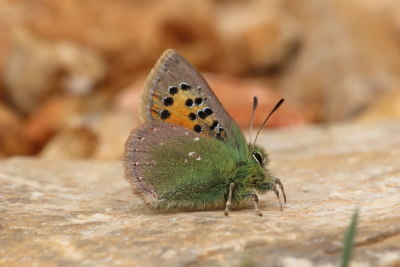

















Provence Hairstreak (Tomares ballus)
2025 photographs highlighted in green. Click on any photograph to go to an enlarged picture, or simply scroll down the page.
|
This is a butterfly of the southern Iberian peninsula with a very localised presence in Var. It broadly has the unf of a Small Copper (Lycaena phlaeas) and the unh of a Green Hairstreak (Callophrys rubi) and never settles with open wings. It has a very early flight season from late March to the end of April. 2007 seemed to be an early season and I saw one individual (the first ever), and it was quite worn even on 19 April. In 2008 I revisited the same site and found at least two individuals, and the same in 2009, plus I found several spread over a wide area at another site. Since then, another two locations have been identified, and by 2012 the total had risen to six known sites in eastern Var.
It is noticeably hairy, quite strange for a species that occurs only in very hot climates. |
T&L shows the female upperside as being largely bright orange, the
male as a consistent darkish brown, and the female as being rather larger than the
male. I first saw females for certain in 2009 and they were clearly lighter in
flight, the orangeness of the uppersides being apparent if not clearly visible.
In recent years, on knowing where to look, I have seen female ballus
egg-laying on what seems to be the preferred larval hostplant, Dorycnium
hirsutum, on several occasions. It is also noticeable that the hindwing is a bright yellow-green (only really apparent in 14526 and the photos post-2018) when fresh, but upon ageing it loses the yellow tinge and takes on a bluish hue. A superb video of the life-cycle of ballus has been produced by Filming VarWild and can be viewed on YouTube here: www.youtube.com/watch?v=NJs9sb4C6TI&feature=c4-overview-vl&list=PLLIrjN9bA2GzCdEV0j2IFQU55FNxoJsGT |
| ref | sex |
observations |
alt. m |
| 19758 | M |
a male, I believe, a highly territorial pose. |
220 |
| 24097 | M | a rather aged male, hence the bluish tinge to the unh. | 185 |
| 45900 | M | as 2019 was a very late season, especially in the spring, the males at this location still had the very appealing yellow-green of the unh. | 220 |
| 45903 | M | the same comment as for 45900. | 220 |
| 31893 | M | a male, still rather green considering it was at the end of the flight period, despite the lateness of the 2013 spring. | 140 |
| 34453 | M | a male, I believe. It has some degree of wear and is rather bluish, rather than the yellow-green of fresher specimens. | 220 |
| 36912 | M | a rather dusky male. | 140 |
| 40064 | M | a male, reasonably fresh but the green colour is starting to turn bluish. | 220 |
| 45069 | M | a male. My arrival each year in Var is in the second week of April which usually means that I am seeing ballus when it is slightly past its freshest. However, 2018 was a very late year and so I was fortunate that the ballus were still quite fresh even in mid-April and 45069 is a very good example of the yellow-green colour of this species when fresh. | 220 |
| 36887 | F? | a female on what appears to be low lying D. hirsutum. | 220 |
| 14526 | F |
could possibly be considered a male, based on its pose and its behaviour at the time. On studying the magnified image, the end of the foreleg appears to be articulated and identical to the mid-leg and hind-leg and not hooked, which confirms that this is a female. It appears to be quite fresh, judging from the yellowness of the unh. |
220 |
| 19553 | F |
possibly a female, largely based on its behaviour at the time, and possibly also the rounded shape of the hindwing at the anal angle. The forewing apex is not pointed as I would expect for a female (see 14499), though. On studying the magnified image, the end of the foreleg appears to be articulated and identical to the mid-leg and hind-leg and not hooked, which confirms that this is a female. |
140 |
| 14499 | F |
clearly a female, as it is egg-laying. The forewing appears quite pointed and the forewing costa slightly convex at the apex, so maybe this feature is a semi-reliable clue to the sex. I am puzzled as the plant it is laying on; Lafranchis gives several larval hostplants (of genus Anthyllis, Medicago, Hippocrepis, Onobrychis, Dorycnium, Lotus), all of which are low-lying, but the plant in 14499 and 14500 does not appear to be any of those listed and does not appear to be low-lying. I have not yet been able to identify this plant, so any help here would be welcome. |
140 |
| 28612 | F | a female that had been egg-laying on what I believe is D. hirsutum. | 220 |
| 42341 | F | a female, slightly fresher than most on this page, egg-laying on D. hirsutum. | 220 |
| 42368 | F | I had recorded 42368 as ballus at the time, maybe on the grounds of its behaviour. | 220 |
| 42378 | F | 42378 was behaving very oddly, flying very little and remaining motionless for quite long periods. It was only on studying the photograph that it appeared that the end of the antennal club was missing, perhaps cut off during an attack by a predator. Either way, it would explain the strange behaviour. | 220 |
| 14500 | ovum |
an ovum, not necessarily the one laid by 14499. |
140 |